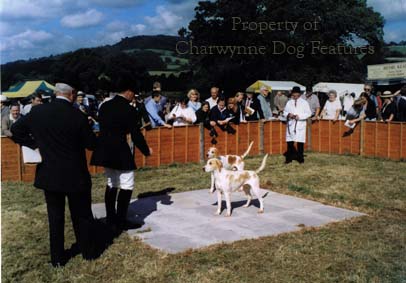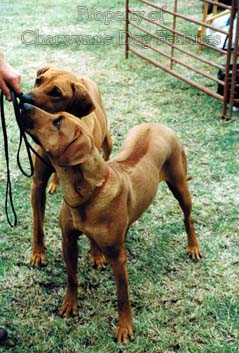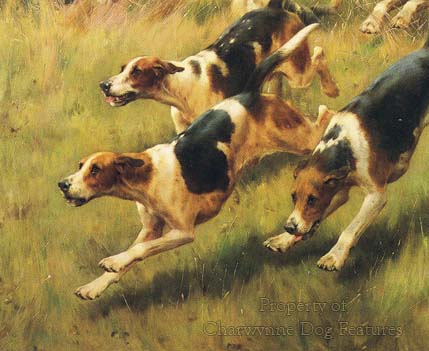431 Loins
LEARNING ABOUT LOINS
by David Hancock
.jpg) In their commendable emphasis on superlative shoulders, foxhound men have sometimes undervalued other parts of a hound's anatomy, which is not always wise. A sound physique is surely the key element in any hound's make-up, with every part of it contributing to a successful hunting dog. In his editorial notes to Beckford's celebrated 'Thoughts on Hunting' of a century ago, Otho Paget wrote that 'Backs and loins should always be there, but a good shoulder is a necessity.' I would have thought that a good loin was as important and is so often an undervalued part of the hound's anatomy. As Richard Clapham points out in his 'Foxes, Foxhounds and Foxhunting': 'Show judges are apt to pay more attention to the fore-end of a hound than his hind-quarters, but this is a great mistake, for it should be remembered that pace and jumping ability are derived solely from the hind-quarters.'
In their commendable emphasis on superlative shoulders, foxhound men have sometimes undervalued other parts of a hound's anatomy, which is not always wise. A sound physique is surely the key element in any hound's make-up, with every part of it contributing to a successful hunting dog. In his editorial notes to Beckford's celebrated 'Thoughts on Hunting' of a century ago, Otho Paget wrote that 'Backs and loins should always be there, but a good shoulder is a necessity.' I would have thought that a good loin was as important and is so often an undervalued part of the hound's anatomy. As Richard Clapham points out in his 'Foxes, Foxhounds and Foxhunting': 'Show judges are apt to pay more attention to the fore-end of a hound than his hind-quarters, but this is a great mistake, for it should be remembered that pace and jumping ability are derived solely from the hind-quarters.' 
It is not unusual for those involved in dogs to be fairly hazy about the loin. I can recall standing ringside at a houndshow, alongside a former MRH and a distinguished judge, and listening to his observations, especially those based on his confusing the hounds' flanks with their loins! A much-respected lurcher breeder once told me that for years he had thought that the loin was another word for the groin. I once sat through a two hour lecture on locomotion in the dog, given by a lecturer from a vet school, and realised that the loin had not been mentioned once. He did refer to muscles like the rectus abdominis, the principal flexor of the spine, the great oblique, which arches the back, flexes the spine or inclines it laterally, and the lumbo-dorsal/thoracolumbar fascia, where the loin is situated.
This distinguished scientist was so used to lecturing to students, undergraduates with a good knowledge of anatomy, that he had forgotten the importance of respectful simplification to an audience which lacked specialist knowledge but contained people just as intelligent, and certainly more perceptive, than he. What he lacked the empathy to explain was that the loins comprise the lumbar area, extending from the end of the rib cage to the start of the pelvis, forming the upper section of the couplings region. 
The coupling comprises the whole muscular band joining the chest and hindquarters, not just in the loin area. The loins overlie the lumbar vertebrae, can differ in length, flexibility and capability, according to the length of these bones and their substance, as well as to the width of their prominence on each side. This accounts for breed differences, originating in function. Not surprisingly, the loins of a Foxhound are not the same as those in a terrier.
No breed wants sagging loins, giving a drooping backline at the coupling. But requirements vary in breeds from slightly tucked loins, arched loins and a need to be 'light in loins'. Judges of every breed need to be aware of the loin. Good length of loin can make a dog look more rectangular than square, when the actual distance from the sternum to the point of buttock is in reality not much greater than the height at the withers. A short-loined exhibit can so often be more eye-catching, especially if it displays a long neck and upright shoulders, but it is not a sound animal.
The long dorsal muscle, which extends the spine or bends it to one side, is especially noticeable in the loins, where each vertebral bone carries the weight of the body in front of it, together with the weight of its own body mass. Towards the sacrum, each vertebra is accepting greater total weight than the one before it - the vertebrae get bigger, moving rearwards, throughout the lumbar region. It is not difficult to appreciate therefore the importance to a substantial breed, like the Bloodhound, as well as the fast lithe leaping dog, of the loin. Breeders of Foxhounds have long been aware of this importance, but perhaps haven't always given it the attention it merits.
Hound breeders have long acknowledged the impact made by sagging loins on endurance, but also knew the limitations of the hound being too short-coupled. Generally speaking, over-shortness of body, as opposed to shortness of back, carries more disadvantages than a little extra length, which gives more flexibility and easier whelping. A good Bull Terrier demonstrates this point well. It is vitally important for judges to know how to spot the cricial difference between a long body and a long back; the two don't always coincide!
Knowledge of how a dog's anatomy works, rather than mystical powers, is why the so-called gift of 'an eye for a dog' puts one judge in a different class from another. A desirable arched loin can be confused with a roach or sway back. An exhibit may get away with a sagging loin in the show ring or even on the flags at a houndshow; but it would never do so as a working or sporting dog. It would lack endurance and would suffer in old age. Yet it is, for me, comparatively rare to witness a judge in any ring in any breed test the scope, muscularity and hardness of the loin through a hands-on examination. For such a vital part of the dog's anatomy to go unjudged is a travesty. The lumbar vertebrae are quite literally the backbones of the loins, lumbus being Latin for loin. Any arch should be over the lumbar vertebrae and not further forward.
An obsession with shoulders can lead to the overlooking of failings elsewhere in the hound; the whole hound needs scrutiny, with total soundness being the key. In his own book 'Hunting' of 1900, Otho Paget wrote 'The merest novice amongst hounds will be struck at once on visiting Belvoir with the character and quality of the pack. At the first glance your eye fails to distinguish one hound from another: they are all of one type, yet each has an individuality of its own, which gradually comes to you as you look more closely. They have bone and strength, yet there is no lumber, and every movement denotes activity. Legs and feet are perfection; backs and loins appear made to carry muscle; and the thighs, over which the rippling sinews play, suggest a graceful strength. Generations of careful breeding have imparted to this pack a certain dignified air of calm superiority...' He was clearly assessing the hounds on their overall merit, rather than stressing one particular physical feature. And he didn't overlook the loin.
In an attempt to appreciate the value of the loin to the dog, I think of the dog as a four-wheel drive rear-engined vehicle with its transmission in the loins. They are an absolutely key feature of the canine anatomy relating to movement. If we prize movement then we must understand the loins. But just try researching the subject even in weighty books on dogs, and even in those on packhounds. Anyone assessing a hound on the flags who doesn't check the strength of loin in each and every exhibit has a lot, as they say in Chicago, to 'loin'!